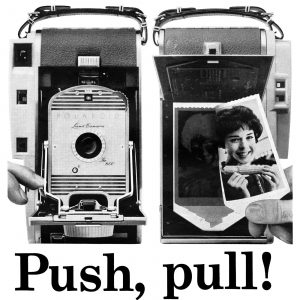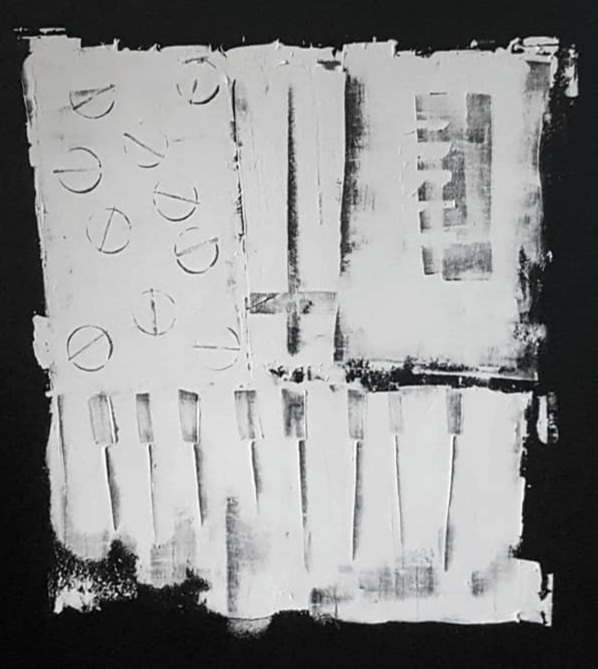In: collection

The Polaroid Book : Selections from the Polaroid Collections of Photography
January 5, 2023The Polaroid Book : Selections from the Polaroid Collections of Photography
Edited by Steve Crist, Essay by Barbara Hitchcock
Taschen 2005

As a photographer, and especially as one who has shot a lot of instant film, I could wax poetic about the wonders of the Polaroid film process; that it was invented in 1947 by Edwin Land and his Polaroid Corporation; that he formed a partnership with Ansel Adams to explore the artistic capabilities of the medium in 1948; that Land and the Corporation made hundreds of cameras and film available to artists around the world on the condition that they gave some of their images to Polaroid’s collection of photos. I could tell you that it was THE photographic medium of the 50’s, 60’s, 70’s and 80’s and that creating a photo was indeed as easy as “Push, pull!”. However, there are so many writers and photographers out there who have extolled the virtues of the process over the last 75 years that I can’t possibly say anything new.
The Polaroid Book : Selections from the Polaroid Collections of Photography tells the story in 254 photographs by 203 artists. The photos include black and white documentary and landscape images taken with the cumbersome early models of the Polaroid line of cameras to incredibly immersive large format color images made by celebrated artists and fashion photographers. The creativity in these polaroids is boundless. From Adams to Warhol with a little Close and Hockney in between, Polaroids were a tool used by well (and lesser) known artists to create stunning pieces of work. Chuck Close’s Self-portrait (seen below) stands out; a mosaic made up of 9 separate images to create a large, somewhat disjointed selfie in Close’s trademark (and usually painted) style.
Perusing this book will lead you to want to try capturing this photo-magic yourself, which you can do by using Fujifilm’s Instax line of film and cameras. Anecdotal evidence points to these colourful, well designed cameras acting as lures to teens everywhere to further explore the possibility available to them in analog photography as a creative outlet. It is one of the reasons that film sales are quickly growing again after years of domination of the market by digital photography.
The Polaroid Book is available from numerous online and bricks-and-mortar retailers.
~ Mark Walton
Read More
Tony Calzetta – Art Is Hell
April 22, 2022Tony Calzetta Art Is Hell Bart Gazzola sat down to talk with Tony Calzetta, whose decades long practice has been both... Read More

Renée Mathews: Fluidity and Intuition – Femme Folks Fest Repost
March 18, 2022Renée Mathews: Fluidity and Intuition by Glodeane Brown, Guest Curator SECRETS by Renée Mathews The COVERT Collective is pleased to be... Read More

Maria Simmons – Fermentation of Ideas – Femme Folks Fest Special
March 17, 2022Maria Simmons Fermentation of Ideas The COVERT Collective is pleased to be participating in Femme Folks Fest 2022. Maria Simmons is an eclectic,... Read More

Laura Jones – A Life in Photography – Femme Folks Fest Special
March 16, 2022Laura Jones A Life in Photography ~ Laura Jones The COVERT Collective is pleased to be participating in Femme Folks Fest 2022.... Read More

Essay – Ron Hewson – Community Galleries
March 1, 2022Community Galleries
I’ve been putting a lot time and effort lately into a community gallery that I belong to. While doing this I’ve put some thought into why I feel it’s worth the effort. Here are some of my reasons to to belong to and participating in this endeavour.
I believe it’s important for local artists to have a place to hang their work. Putting my work on a wall in a public space means I feel that I have created something that is worthy of public display. This matters because the emotional investment in producing art needs that outlet. Showing in a gallery is the reward for the time and money put into our work. I know I would continue to work regardless of belonging to a gallery but knowing that I can share what I have made is incentive to keep working.
Belonging to the gallery means I have to finish things. Every couple months I need new framed finished work to display. As a photographer I can capture a vast number of images. However that really doesn’t mean anything if I don’t finish any of them. Sure I can do some quick editing and post them on Instagram or do some more careful work and post on a stock photo site but that’s not the same as taking the extra steps to print and frame something. The incentive to finish work is a big benefit of belonging to the gallery.
Preparing work for the community gallery on a regular basis is far less stressful that preparing for a major gallery show. I’ve done shows at “big” galleries. The thrill and sense of accomplishment that comes from that kind of show can’t be beat. But the investment in time and money can be overwhelming. Its not something that everyone is prepared to do or is willing to do and for most people its out of reach. The community gallery fills that need perfectly. It gives the opportunity to exhibit that is manageable for artists who want to exhibit without the stress of a solo show.
There are many other reason the gallery is worth my time such as the diversity of the art on display and the camaraderie of follow artists but what makes to gallery valuable to me is the incentive to keep working. I believe that everyone needs some form of incentive and that for me is to have my photography physically present in the world. While posting something online might get seen by lots of people we don’t paint or sculpt or create our art to be seen on a phone.
Visit uptowngallerywaterloo.com
~ Ron Hewson
Read More
Chris Reilly – Balancing Act
February 4, 2022Chris Reilly Balancing Act Untitled by Chris Reilly Chris Reilly is an artist whose works are about seeking balance while also... Read More

Lori Coulter – Diviner
January 27, 2022Lori Coulter Diviner this piece is tilted... loose page by Lori Coulter When you view Lori Coulter's work, it's almost as... Read More

The Museum of Everything: Volume #4 – You’re Not Only Human
January 24, 2022The Museum of Everything: Volume #4 – You’re Not Only Human
Everything Ltd/The Museum of Everything
The Museum of Everything
I have collected a lot of catalogues over the years. Some for shows I’ve visited in person, and some for shows I simply wish I had visited. In 2013, I visited the Venice Biennale. It was pure serendipity that the inspiration (and title) for the 2012 iteration, curated by Massimiliano Gioni, was The Encyclopedic Palace: the concept first patented in 1955 by self-taught artist, Marino Auriti, of an imaginary museum “meant to house all worldly knowledge, bringing together the greatest discoveries of the human race, from the wheel to the satellite.”
Having focused a great deal on ‘outsider art’ during my Masters degree, I was bonkers thrilled to be able to see an exhibition carrying this much weight on the international level, blurring the lines between self taught and academic artists. Aside from the spectacle that was the main exhibition, one of the greatest finds for me was a tiny little pavilion set up outside by The Museum of Everything. Wandering through their set up of reproductions of work by Carlo Zinelli, mounted on pillars, I ended up at their bookstore/gift shop and found one of my most prized possessions to this day.
The Museum of Everything was launched by James Brett in Britain in 2010, and has quickly grown into an institution celebrating who they refer to as, “untrained, unintentional, undiscovered and unclassifiable artists of modern times”. This particular catalogue documents their fourth exhibition, which was presented at Selfridges, London from September 1 – October 25, 2011. The exhibition presented over 500 artists, including the first UK retrospective of Judith Scott – a personal heroine of art-making. The catalogue includes 225 pages of full colour works, organized into categories of studios. Prior to this catalogue, I had been aware of some of the more well known studios/organizations/institutions, like Creative Growth, Gugging and Creativity Explored, but the index provided me with a blueprint for places I would grow to research more, to study, to acquire works from, and to include in exhibitions I dreamt up. Each section includes reproductions of works, alongside statements by the studios they were created in, and cursory descriptions of the artists’ general oeuvre. The catalogue almost becomes a collection of manifestos of support for those creating outside of the academic tradition.
Included in the boxed set is The Appendix of Everything, featuring interviews with heavy hitters like Cindy Sherman, Massimiliano Gioni, David Byrne, and revered director of White Columns, Matthew Higgs. The collection of conversations is informal, accessible, and honest. Many quotes have stuck with me to this day. One in particular, was Higgs’ description of what he felt when he first encountered Creative Growth. “Art was being made for reasons that remained out of reach”. For me, this is the art I’ve developed a tidal wave of emotional reaction to. I look through this catalogue regularly, finding patterns, similarities, moments of clarity, and moments of joy.
You can acquire this catalogue by visiting the Museum of Everything’s website. Also note that there are now 7 catalogues for exhibitions curated by the Museum. ~ Lisa Kehler
Read More
Recent Comments